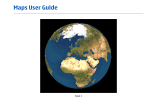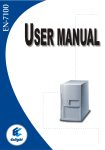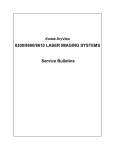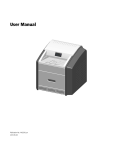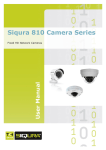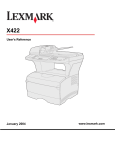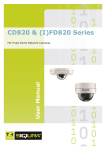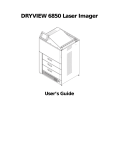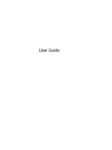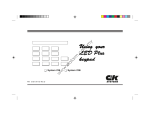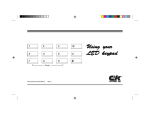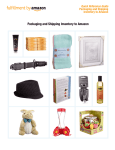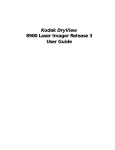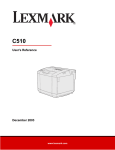Download Environment
Transcript
Environment I N F O R M A T I O N F R O M K O D A K J-700(ENG) $10.00 Health, Safety, and Environmental Technical Summary for KODAK DRYVIEW™ Laser Imaging Systems Kodak’s health safety, and environmental publications are available to help you manage your photographic processing operations in a safe, environmentally sound and cost-effective manner. This bulletin answers the most common environmental, health and safety questions about the four major components of Kodak DryView systems: • Imager • DryView Film • Film Cartridge or Polybag • Air Filtration - Activated Carbon Filter Kodak DryView laser imaging systems consist of equipment: continuous-tone laser imagers with an internal thermal processor; and consumables: a dry photothermographic imaging process that uses heat instead of wet chemicals to develop diagnostic-quality imaging films. DryView systems are also true dry laser imagers; they use laser diodes ©Eastman Kodak Company, 2001 instead of thermal printheads. In fact, they feature the same laser technology originally perfected for wet laser imaging. All of which means users can count on superior gray scale and superb, continuoustone images. This document is organized into three sections: 1. General health, safety, or environmental information and best-management practices specific to the various parts of the DryView Imaging Systems, 2. Appendix I - country-or regionspecific regulatory information, if applicable or appropriate, 3. Appendix II - Kodak Health, Safety, or Environment resources TABLE OF CONTENTS KODAK DRYVIEW™Laser Imaging System...................................................................................................1 KODAK DRYVIEW Imagers ...........................................................................................................................3 How KODAK DRYVIEW Laser Imagers Work ...........................................................................................3 Installation, Operation, and Specifications ...................................................................................................3 Preventive Maintenance ..................................................................................................................................3 End-of-life management ..................................................................................................................................4 KODAK DRYVIEW Film ....................................................................................................................................5 How KODAK DRYVIEW Film Works ..........................................................................................................5 Handling and Storage ......................................................................................................................................5 Transportation ..................................................................................................................................................7 End-Of-Life Management ...............................................................................................................................7 KODAK DRYVIEW Daylight Load Film Cartridge or Polybag ...................................................................7 How KODAK DRYVIEW Daylight Load Film Cartridge or PolyBag Works..........................................7 Handling and Storage ......................................................................................................................................7 Transportation ..................................................................................................................................................7 End-Of-Life Management ...............................................................................................................................8 KODAK DRYVIEW Air Filtration—Activated Carbon Filter .......................................................................8 How the Activated Carbon Filter Works ......................................................................................................8 Handling and Storage ......................................................................................................................................8 End-Of-Life Management ...............................................................................................................................8 Appendix I— Country-Specific Regulatory Information ..............................................................................9 Appendix I-A Canada .....................................................................................................................................9 Appendix I-B European Union ....................................................................................................................11 Appendix I-C United States of America .....................................................................................................13 Appendix II —Kodak Health, Safety, and Environmental Resources .......................................................15 2 Health, Safety, and Environmental Technical Summary for KODAK DRYVIEW™ Laser Imaging Systems • J-700(ENG) KODAK DRYVIEW IMAGERS HOW KODAK DRYVIEW LASER IMAGERS WORK The simple development process of Kodak DryView laser imaging film enables Kodak to develop fully integrated laser imaging systems that are smaller, simpler and easier to use than other systems. In addition, they are less costly to purchase and maintain. When the Kodak DryView 8700 laser imager receives a print command: 1. Suction cups in the pickup area lift a single sheet of film from the film cartridge and feed it into the film transport rollers. 2. The film transport system drives the film into the exposure module. 3. An infrared laser diode exposes the film, and it is fed into the film processor. 4. The film is heat-developed as it passes through the processor. 5. The film passes through the scanning densitometer and into the receive tray. INSTALLATION, OPERATION, AND SPECIFICATIONS For information about the installation and operation of a specific DryView laser imager, as well as technical specifications, please refer to the applicable Kodak DryView Laser Imaging System Customer First User Manual and the Kodak DryView Laser Imaging System User Guide. While there are no special ventilation requirements for using or working with the DryView Laser Imagers, minimum ventilation standards (Appendix I) for general office environments should be met. For further information or guidelines on ventilation, refer to Appendix II for Kodak Health, Safety, and Environmental assistance. PREVENTIVE MAINTENANCE Kodak DryView laser imagers must receive periodic routine preventative maintenance to deliver the highest quality images, reduce low-level odor release, and ensure appropriate airflow. Preventative maintenance is typically performed after every 10,000 cycles or prints. Failure to conduct preventative maintenance may result in unpleasant odors in the operating environment around the processor. Several parts should be cleaned or changed on a scheduled basis to maintain the appropriate working condition of the processor. For example, filters not replaced at proper intervals will hinder air flow and lead to odors in the operating environment. The processing unit has to be cleaned and any debris removed from the air flow pathways that lead air into the carbon filter. During processing, the DryView film is in contact with a drum that has been heated to 121° C. It is during this heat cycle that there may be sublimation from the film. Once this sublimate comes in contact with a cooler surface it precipitates out into a white solid form. This solid form, generally referred to as “FAZ”, can be found on the interior surface of the DryView laser imager cabinet door and also on the charcoal filter. It is a benign substance primarily composed of fatty acids. Health, Safety, and Environmental Technical Summary for KODAK DRYVIEW™ Laser Imaging Systems • J-700(ENG) 3 Since the FAZ is only located on the interior surfaces, there are no concerns for exposure during normal operation of the DryView laser imagers. Kodak has conducted toxicology testing to answer questions regarding possible adverse health effects from exposure to the FAZ during maintenance of the DryView laser imagers. This toxicology testing included skin irritation, eye irritation and dermal sensitization studies. Based on the results of these tests and the composition of the FAZ, there are no known health effects anticipated from exposure to the FAZ. In addition, Kodak field engineers, who service the DryView laser imagers on a daily basis, have not reported any adverse health effects from exposure to the FAZ. Nonetheless, in keeping with good industrial hygiene practices, we recommend that any individual who is performing maintenance on the DryView laser imagers wear protective eyewear and impervious gloves to avoid eye contact and prolonged or repeated skin contact with the FAZ and cleaning solutions. 4 Kodak has conducted emissions studies with DryView imagers under worst case conditions with the equipment fully operational in a closed room without mechanical ventilation or with airflow limited to one room change per hour while operating the imager continuously in automatic mode for four hours at its maximum processing rate. A total of 446 films were produced over the four-hour test. The operator sat on a stool in front of the imager throughout the test, monitoring the performance of the imager and changing film cartridges as needed. Air samples were collected in the breathing zone of the operator. The only material detected at a level significantly above background levels was methyl ethyl ketone (MEK). The concentration of MEK detected was 0.6 part per million (ppm) compared to a background level of 0.2 ppm. This concentration of MEK is significantly below levels reported to cause irritation (100 ppm) and occupational exposure standards (200 ppm). While 0.6 ppm is below the reported odor threshold for MEK (5.4 ppm), it is possible that this level of MEK, along with any background levels normally present in a hospital setting, may be detectable by individuals with a particularly sensitive sense of smell. If this low odor level is an annoyance, you should confirm that the equipment is properly installed; the airflow in the room is adequate; the temperature in the room is comfortable; and the filter in the imager is properly installed and that the filter is being replaced on schedule. Refer to the user manual for specific preventative maintenance tasks and schedules. END-OF-LIFE MANAGEMENT Kodak DryView imagers must be discarded in accordance with local and national regulations. For other country-specific details, please refer to the appendices. Health, Safety, and Environmental Technical Summary for KODAK DRYVIEW™ Laser Imaging Systems • J-700(ENG) KODAK DRYVIEW FILM HOW KODAK DRYVIEW FILM WORKS Kodak DryView laser imaging film is a high-resolution, infraredsensitive, photothermographic film especially designed for Kodak DryView laser imaging systems. Like traditional wet films, Kodak DryView laser imaging film is a silver-based photographic film. A light-sensitive layer forms a latent image when exposed to light from an infrared diode. However, Kodak DryView laser imaging film differs from traditional film in one key aspect: it only requires exposure to moderate temperatures for development—approximately 121° C for 15 seconds rather than development by wet chemistry. A combination of silver and selfcontained developers in the imaging layer gives Kodak DryView laser imaging film its unique ”photothermographic“ properties (light-sensitive, developed with heat). Upon processing, all of the silver remains after processing, eliminating the need to dispose of silver-laden solutions. HANDLING AND STORAGE Fire Hazard and Extinguishing Media DryView films pass the standard safety film test described in ”ISO 543-Photography Photographic Films - Specifications for safety film.“ This International Standard provides specifications and test procedures for establishing the safety of photographic films with respect to hazards from fire. Although the polyethylene terephthalate (known as ”polyester“) film base used in DryView film is a combustible material, it is not easily flammable. Considerable heating above ambient conditions is required before ignition and combustion can occur (approximate ignition temperature 480 °C). The products of thermal degradation of polyester film (at 270 °C) and combustion depend on the burning conditions and are likely to include carbon dioxide, carbon monoxide, aliphatic hydrocarbons, and aldehydes (acetaldehyde and butyraldehyde). Pre-Processed Film Unprocessed Kodak DryView film is contained in Kodak's DryView Daylight Load Film Cartridges and Poly Bags. It must be stored in a cool, dry place, at temperatures between 5°C to 25°C, and protected from radiation and chemistry vapors or gases. Locating DryView Imagers away from wet processors can ensure that the DryView film will not be exposed to chemistry vapors. The film will tolerate short-term temperature spikes (up to 32°C for up to two days) without any significant effect on film quality or performance. However, temperatures above those recommended for storage will gradually diminish shelf life. Processed Film Under recommended use and storage conditions, tests in accordance with the American National Standards Institute (ANSI) test method IT9.24 indicate that processed Kodak DryView film will maintain diagnostic quality for more than 100 years. Processed Kodak DryView film is not significantly affected by spills, humidity, or other moisture. If necessary for cleaning, films can be wiped with a clean, damp cloth. Prolonged exposure to intense light or excessive heat (54°C for more than eight hours) may cause some gradual darkening of images (e.g. leaving film in a vehicle for extended periods of time at elevated temperatures). You can leave Kodak DryView film on most light boxes for 24 hours Health, Safety, and Environmental Technical Summary for KODAK DRYVIEW™ Laser Imaging Systems • J-700(ENG) 5 or more. However, if light boxes are exceptionally hot (49°C), films may begin to exhibit slight density changes after eight hours of continuous exposure. Be careful when using spotlight viewing for more than 30 seconds, because temperatures near the light source may exceed 82°C causing gradual darkening of the image. We do not recommend using DryView film in slide projectors or overhead projectors due to the high temperatures generally found in these devices, which can also result in gradual darkening of the image. A small amount of final development occurs after each DryView film exits the Kodak DryView laser imager and is exposed to ambient or view box lighting. This is virtually undetectable, and has an insignificant effect on image qualitytypically 0.02 change in density. This increase is uniform and permanent upon full exposure of the film under normal handling conditions (room light or view box). DryView film differs from traditional X-ray film in that it may have a very slight odor (described by some as "fruity") which is noticeable to a small percentage of of users. Steps are taken to control this mild odor during the manufacturing process and also by the use of an absorbent filter in the DryView imager (discussed previously). To address any concerns about odors, the DryView imaging system has been tested under worst-case conditions with the equipment fully operational in a confined space with little to no ventilation. Industrial hygiene samples of the air around the operating system show that only very low levels of the carrier, principally methyl ethyl ketone, can be detected. The levels of methyl ethyl ketone detected are less than 1 ppm, which is significantly below levels reported to cause irritation or any other effects (100 ppm) and established occupational exposure standards (200 ppm). However, this level of methyl ethyl ketone, along with any background levels normally present in a hospital setting, may be detectable by individuals with a particularly sensitive sense of smell. If this low odor level is an annoyance, you should confirm that the air flow in the film reading room or film storage area is adequate; the temperature in these areas is comfortable; and that paper sleeves (instead of plastic sleeves) are used to store the film. There are no special ventilation requirements for working with the DryView film. However, minimum ventilation standards for general office environments should be followed for physician reading rooms and film storage areas. Please refer to the appendices for country-specific information and for Kodak environmental resources available in your country, including obtaining an Article Information Sheet about DryView film. Health, Safety, and Environmental Technical Summary for KODAK DRYVIEW™ Laser Imaging Systems • J-700(ENG) 6 TRANSPORTATION Refer to Appendix I for countryspecific regulatory information. END-OF-LIFE MANAGEMENT Unlike some dry laser imaging films, processed and unprocessed Kodak DryView films contain silver (approximately 6 to 10 g of silver per kilogram of film). Since silver is not removed from the film during development, the silver from unprocessed and processed film should be recovered before further reclamation or disposal. The base material (polyester) of the film is also recoverable, although recovery facilities may not exist in all locations. In the absence of recovery facilities or processes to work with DryView film, film may be disposed of and silver reclaimed through the use of incineration with energy recovery. Third-party providers may be available to reclaim silver through incineration. The best way to determine recycling options in your area is to contact scrap film buyers. These companies may or may not require film segregation (i.e., separating silver halide film, DryView film, and other “dry” films, etc.). In the absence of suitable incineration facilities, a review of the composition and properties of these materials indicates that disposal to a landfill will not result in a significant risk of adverse environmental effects. For more details, as well as country-specific environmental information, please refer to the appendices. KODAK DRYVIEW DAYLIGHT LOAD FILM CARTRIDGE OR POLYBAG HANDLING AND STORAGE Since the cartridge houses unprocessed Kodak DryView film, please refer to the Film Handling and Storage section for ”Unprocessed Film“. TRANSPORTATION Refer to Appendix I for countryspecific regulatory information. HOW KODAK DRYVIEW DAYLIGHT LOAD FILM CARTRIDGE OR POLYBAG WORKS Kodak's DryView Daylight Load Film Cartridge or Film Polybag contains unprocessed DryView film. These devices are an integral part of the film product. The cartridge or film polybag make handling DryView film simple. Load the cartridge or the film polybag into the imager as shown in the user manual and pick up ready-to-view films as they exit the top of the imager. There are no darkroom procedures required for DryView film loading. Health, Safety, and Environmental Technical Summary for KODAK DRYVIEW™ Laser Imaging Systems • J-700(ENG) 7 END-OF-LIFE MANAGEMENT Unused cartridges or film polybags contain film. If disposal of unused cartridges is required, please also refer to the ”Film-End of Life Management Section“. Cartridges are made of ABS plastic with a laminated plastic lid, secured by an adhesive layer. Inside the cartridge there is a plastic film liner to avoid misfeeding. All those components are recoverable, although recovery facilities may not exist in all locations. In the absence of recovery facilities, film cartridge waste can be disposed of by incineration with energy recovery. In the absence of suitable incineration facilities, a review of the composition and properties of these materials indicates that disposal to a landfill will not result in a significant risk of adverse environmental effects. For country-specific details, recycling programs available in your area, and country-specific environmental resources, please refer to the Appendices. 8 KODAK DRYVIEW AIR FILTRATION— ACTIVATED CARBON FILTER HOW THE ACTIVATED CARBON FILTER WORKS The filter used in Kodak DryView laser imagers is a granular activated carbon filter encased in a nonwoven polymeric scrim and highdensity polyethylene (HIPS) plastic casing. The filter absorbs and neutralizes the slight odor that DryView laser imaging film emits during development. The main constituent is methyl ethyl ketone. HANDLING AND STORAGE Part of the preventative maintenance for the DryView Imager is periodic replacement of the activated charcoal filter. Store the filter in its plastic sleeve and packaging until ready for use. END-OF-LIFE MANAGEMENT Refer to Appendix I for countryspecific regulatory information. For country-specific environmental resources, please refer to Appendix II. Health, Safety, and Environmental Technical Summary for KODAK DRYVIEW™ Laser Imaging Systems • J-700(ENG) APPENDIX I — COUNTRY-SPECIFIC REGULATORY INFORMATION APPENDIX I-A CANADA KODAK DRYVIEW IMAGERS Imager Installation, Operation and Specifications DryView laser imagers have no special requirements for ventilation. However, guidelines for office environments—such as American Society of Heating, Refrigeration, and Air Conditioning Engineers (ASHRAE)—should be met. Refer to the Kodak Environmental Services Indoor Air Quality Environmental Technical Bulletin, J-319, for additional information. Visit the Kodak Environmental Services website at www.kodak.com/go/kes. Transportation Not subject to the Transportation of Dangerous Goods Regulations. End-of-Life According to Federal regulations in Canada, Kodak DryView film is not a hazardous waste product. Disposal may be subject to provincial and municipal laws. To obtain a list of scrap film buyers, visit the Kodak Environmental Services (KES) website at www.kodak.com/go/kes or call 1-800-GO-Kodak (1-800-465-6325), ext. 35190. In addition, if quantity thresholds are met, Kodak Silver Refining Services is able to recycle DryView film. For information about Kodak Silver Refining Services, please visit the KES website. End-of-Life Management DryView laser imagers may be subject to local management requirements for end-of-life electrical and electronic equipment. Contact your Kodak representative or refer to Appendix II for resources in your area. KODAK DRYVIEW FILM Handling and Storage DryView film requires no special ventilation. However, general guidelines for office environments—as issued by the American Society of Heating, Refrigeration, and Air Conditioning Engineers (ASHRAE)—should be followed for physician reading rooms and film storage areas. Refer to the Kodak Environmental Services Indoor Air Quality Environmental Technical Bulletin, J-319, for additional information. Visit the Kodak Environmental Services website at www.kodak.com/go/kes. KODAK DRYVIEW DAYLIGHT LOAD FILM CARTRIDGE Handling and Storage There are no federal - or provincial-specific regulatory handling or storage requirements for the DryView activated carbon filter. Transportation Not subject to the Transportation of Dangerous Goods Regulations. End-of-Life Kodak provides a free, easy and convenient way for DryView customers to return Daylight Load Film Cartridges for reuse and recycling. This eliminates film cartridge waste, which means cost savings for your facility. If you would like to participate, or if you would simply like more information, call 1-800-440-3336, ext. 35278. Health, Safety, and Environmental Technical Summary for KODAK DRYVIEW™ Laser Imaging Systems • J-700(ENG) 9 KODAK DRYVIEW ACTIVATED CARBON FILTER Handling and Storage There are no federal- or provincial-specific regulatory handling or storage requirements for the DryView Activated Carbon filter. Transportation Cartridges are not a regulated waste when transported in the imager, therefore, they are not subject to the Transportation of Dangerous Goods Regulations. End-of-Life In Canada, under federal legislation the activated carbon filters are not classified as a hazardous waste. Disposal may be subject to provincial or municipal laws. Check with local authorities for advice on the management of this waste. 10 Health, Safety, and Environmental Technical Summary for KODAK DRYVIEW™ Laser Imaging Systems • J-700(ENG) APPENDIX I-B EUROPEAN UNION KODAK DRYVIEW IMAGERS Imager Installation, Operation and Specifications DryView laser imagers have no special requirements for ventilation. However, you should follow local guidelines for ventilating office environments implementing the general provisions of EC Directive 89/654/EEC. End-of-Life Management DryView laser imagers may be subject to local management requirements for end-of-life electrical and electronic equipment. Contact your Kodak representative or refer to Appendix II for resources in your area. KODAK DRYVIEW FILM Handling and Storage KODAK DRYVIEW DAYLIGHT LOAD FILM CARTRIDGE Handling and Storage There are no country- or region-specific regulatory handling or storage requirements for DryView film cartridge or packaging. Transportation There are no country- or region-specific transportation requirements for DryView film cartridge or packaging. End-of-Life The used DryView cartridge is an end-of-life product, not a packaging component. Therefore, it is not subject to the requirements of European packaging regulations, and should not be included in the fee payments associated with local packaging take-back and recovery schemes. There are no country- or region-specific regulatory handling or storage requirements for DryView film Transportation DryView film is not subject to EU legislation regulating the classification, packaging, and labeling of dangerous substances or preparations. Transfrontier shipment of film waste for recovery is regulated under the EC Regulation 259/93. Both unused and processed film are classified on the Green List as Category GO 040. End-of-Life Film may be allocated European Waste Catalogue Code 09 01 07 (photographic film and paper containing silver or silver compounds). Waste unprocessed, or processed DryView film, is not listed as hazardous under the EC Hazardous Waste Directives. Health, Safety, and Environmental Technical Summary for KODAK DRYVIEW™ Laser Imaging Systems • J-700(ENG) 11 KODAK DRYVIEW ACTIVATED CARBON FILTER Handling and Storage There are no country- or region-specific regulatory handling or storage requirements for the DryView activated carbon filter. Transportation There are no country- or region-specific transportation requirements for the DryView activated carbon filter. End-of-Life Although used activated carbon filters from the DryView laser imager are not specifically described in the EU list of waste and hazardous waste, local authorities may classify them as a hazardous waste. Advice on the most appropriate waste code and classification should be sought from these authorities. In Italy, even if the quantities of activated carbon are small, the waste is considered hazardous. The most applicable EWC is ”061302 Carbone attivo esaurito“ located under the EWC Chapter ”060000 waste from inorganic chemical process.“ 12 Health, Safety, and Environmental Technical Summary for KODAK DRYVIEW™ Laser Imaging Systems • J-700(ENG) APPENDIX I-C UNITED STATES OF AMERICA KODAK DRYVIEW IMAGERS information about Kodak Silver Refining Services, please visit the KES website. Imager Installation, Operation and Specifications DryView laser imagers have no special requirements for ventilation. However, you should meet guidelines for office environments as issued by the American Society of Heating, Refrigeration, and Air Conditioning Engineers (ASHRAE). Refer to the Kodak Environmental Services Indoor Air Quality Environmental Technical Bulletin, J-319, for additional information. Visit the Kodak Environmental Services website at www.kodak.com/go/kes. End-of-Life Management DryView laser imagers may be subject to local management requirements for end-of-life electrical and electronic equipment. Contact your Kodak representative or refer to Appendix II for resources in your area. KODAK DRYVIEW FILM Handling and Storage KODAK DRYVIEW DAYLIGHT LOAD FILM CARTRIDGE Handling and Storage There are no country- or state- specific regulatory handling or storage requirements for the DryView Activated Carbon filter. Transportation Not subject to Department of Transportation Hazardous Materials Regulations. End-of-Life Kodak provides a free, easy and convenient way for DryView customers to return Daylight Load Film Cartridges for reuse and recycling. This eliminates film cartridge waste, which means cost savings for your facility. If you would like to participate, or if you would simply like more information, call 1-800-328-2910 and choose option 1, or call 1-800-677-9933. DryView film requires no special ventilation. However, general guidelines for office environments—as issued by the American Society of Heating, Refrigeration, and Air Conditioning Engineers (ASHRAE)—should be followed for physician reading rooms and film storage areas. Refer to the Kodak Environmental Services Indoor Air Quality Environmental Technical Bulletin, J-319, for additional information. Visit the Kodak Environmental Services website at www.kodak.com/ go/kes. Transportation Not subject to Department of Transportation Hazardous Materials Regulations. End-of-Life According to federal regulations in the United States, Kodak DryView film is not a hazardous waste product, so it may be disposed of safely in a landfill. To obtain a list of scrap film buyers, visit the Kodak Environmental Services (KES) website at www.kodak.com/go/kes or call KES (Appendix II). In addition, if quantity thresholds are met, Kodak Silver Refining Services is able to recycle DryView film. For Health, Safety, and Environmental Technical Summary for KODAK DRYVIEW™ Laser Imaging Systems • J-700(ENG) 13 KODAK DRYVIEW ACTIVATED CARBON FILTER Handling and Storage There are no country- or state- specific regulatory handling or storage requirements for the DryView Activated Carbon filter. Transportation Not subject to Department of Transportation Hazardous Materials Regulations. End-of-Life In the United States, under the Resource Conservation and Recovery Act (RCRA) and California Title 22, activated carbon filters used in Kodak DryView laser imagers are not classified as U.S. EPA RCRA or California hazardous waste. Spent carbon was tested using the Toxicity Characteristic Leaching Procedure (TCLP). Spent carbon did not leach any RCRA listed metals or organics above regulatory limits. The filters may be disposed of as non-hazardous waste. Disposal in a landfill, or incineration with energy recovery in a municipal, commercial or industrial facility is appropriate. Contact your state or local government to determine if any additional disposal requirements apply. 14 Health, Safety, and Environmental Technical Summary for KODAK DRYVIEW™ Laser Imaging Systems • J-700(ENG) APPENDIX II —KODAK HEALTH, SAFETY, AND ENVIRONMENTAL RESOURCES Country HSE Web Assistance United States and Canada www.kodak.com/go/kes Phone Assistance HSE-related inquiries: Kodak Environmental Services: call 585-477-3194 (or 800-242-2424 and ask for Kodak Environmental Services and you will be transferred). E-mail: [email protected] U.S. DryView Film Cartridge Recycling Program Information and Participation: 1- 800-328-2910 (option 1) or 1-800-677-9933 or visit www.kodak.com/go/KES and go to the recycling section for program information. Canada DryView Film Cartridge Recycling Program Information and Participation: 1-800-465-6325, ext. 35278 or visit www.kodak.com/go/KES and go to the recycling section for program information Product-related Questions: Kodak Health Imaging Customer Care Center (Product Related Information): 1-800-328-2910 All Others www.kodak.com/go/kes Contact your local Kodak representative for additional information or e-mail: [email protected] The products and services described in this publication may not be available in all countries. Contact your local Kodak representative, or your usual supplier of Kodak products. Health, Safety, and Environmental Technical Summary for KODAK DRYVIEW™ Laser Imaging Systems • J-700(ENG) 15 This publication is a guide to the Federal Environmental Regulations that apply to a typical photographic processing facility. Local or state requirements may also apply. Verify the specific requirements for your facility. EASTMAN KODAK COMPANY • ROCHESTER, NY 14650 Health, Safety, and Environmental Technical Summary for KODAK DRYVIEW™ Laser Imaging Systems KODAK Publication No. J-700(ENG) Kodak and DryView are trademarks. New 3-02 Printed in U.S.A.
















